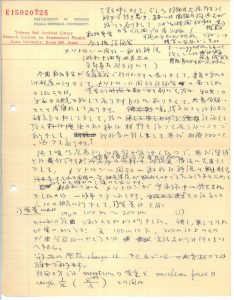Archive of historical materials

Introduction to the Mesotron
OU1939-A2 (5 pages) Date: April 3, 1939
The annual meeting of the Physical and Mathematical Society of Japan took place at Kyoto Imperial University this year and debates on mesotrons (mesons) were held. Yukawa was asked to present a general explanation and opening remarks. This note contains the summary that Yukawa prepared for his lecture at the meeting. After Yukawa’s presentation, various research results were reported and debated. Yukawa was slated to transfer from Osaka Imperial University to Kyoto Imperial University this year in May.
After completing the manuscript, Yukawa added the following comment at the beginning: “The theories reached deadlocks and the difficult problems are remaining. It may not be possible to resolve the impasse based on conventional quantum mechanics.” The first section in the original manuscript starts with a pessimistic tone: “Unfortunately, our group does not have many materials worthy of debate…”
In contrast with his distress, Yukawa’s explanation of the mesotron was simple and down to the point. It was wonderful. The “mesotron” was the new particle that Yukawa introduced for the first time in November 1934 for the purpose of explaining the nuclear force. Near the end of the lecture, Yukawa mentioned the various terms used to refer to the new particle. He said that the particles were called “heavy electrons,” “varitrons,” “U particles” or “mesons” and that it was finally decided to called them mesotrons.
Yukawa first summarized the properties of the mesotrons that had been confirmed in the experiments: (1) Its mass is 100 times to 200 times the mass of electron, (2) Its electric charge can be positive or negative, and (3) The range of the nuclear force resulting from the mesotron is 2 to 4 x 10^{-13} cm, which corresponds with the mass. However, judging from the properties of the nuclear force, neutral mesotrons without electric charge were also necessary; however, they had not been confirmed in experiments. Yukawa stressed the need to investigate whether neutral mesotrons exist in cosmic rays.
Yukawa’s view on the spin and statistics of the mesotron was interesting. At the time of this lecture, Yukawa thought it was most logical to regard the mesotron as a boson with spin-1. In the paper written in 1934, Yukawa proposed scalar particles with spin-0, but he later focused on the analysis of vector particles with spin-1 based on the detailed examination of the nuclear force. At the present, it is known that both pseudoscalar particles with spin-0 and vector particles with spin-1 are necessary.
Yukawa also introduced the lectures to follow: 31. Nishina, 32. Tamaki-Ozaki, 33-34. Kobayashi-Okayama, 35. Sakata-Tanikawa, 36. Yukawa-Sakata and 36. Yukawa. All the lectures up to Lecture 36 were about mesotrons. In the last lecture 37, Yukawa mentioned the limitations of the field theory. (Written by Yutaka Hosotani)


